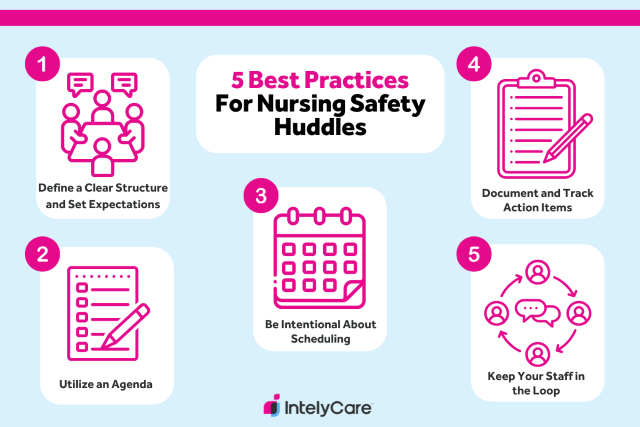Nursing Safety Huddle: 5 Best Practices for Facilities

Conducting a daily safety huddle is an important way to build a culture of safety for both patients and staff. Not only do regular huddles help staff proactively prevent and address medical errors, but they also boost collegiality between unit nurses and leaders.
Striving for efficiency is key to maximizing the benefits of these safety briefings. If you’re looking for tips on how to conduct a well-planned daily huddle, nurse leaders can review the following tips and suggestions.
What Are Safety Huddles in Healthcare?
Safety huddles — also known as safety briefings — are 5- to 10-minute daily meetings where nurses and other care staff discuss all things related to safety in their unit. Beyond flagging any patient-related safety issues, these meetings provide a platform for staff to ask questions or share any concerns regarding practice changes. Additional safety huddle topics include:
- Unit performance metrics.
- Action items to implement.
- The impact of practice changes on patient care outcomes.
- Recognition of unit-wide improvements in safety.
Huddles can take many forms and involve a variety of different staff and leaders. However, there are typically three main types of huddles conducted at a healthcare facility:
|
|
|
|---|---|
| Leadership Huddles | Managers from each unit at a facility meet to report back on safety concerns that require facility-wide action. |
| Daily Shift Huddles | All nursing staff on a unit meet at the start of a shift to discuss safety issues impacting care from the previous day. |
| Post-Event Huddles | Any staff directly involved in a safety incident meet to discuss and address the affected patient’s immediate needs. |
Why Are Safety Huddles in Nursing Necessary?
Communication failures are a primary source of preventable patient harm, accounting for roughly 49% of all medical malpractice claims. For nursing teams, daily shift huddles help prevent these failures and empower nurses to actively partake in safety planning. Dozens of studies support the effectiveness of nursing huddles, demonstrating their significance in:
- Enhancing clinical care outcomes.
- Improving the timeliness of care and assessments.
- Preventing adverse medical and drug-related events.
By touching base with your staff at the beginning of each shift, you have the opportunity to clarify any outstanding concerns and unify your team’s safety-related care goals for the day.
5 Best Practices for Conducting a Team Huddle: Nurse Leaders Guide
Keep in mind that daily huddles are meant to be brief, so it’s crucial to be as organized as possible when executing these meetings. Follow these five best practices when implementing regular briefings with your nursing care team.

1. Define a Clear Structure and Expectations
Since nursing huddles should be no longer than 10 minutes, solidifying a routine structure and setting expectations upfront can improve the flow of these meetings. This includes outlining:
Who will run the meetings: Nurse huddles are usually led by the charge nurse or nurse manager. You may want to assign a static leader or rotate between the charge nurse and manager depending on who’s available during each shift. Either way, it’s important to clearly define who’s responsible for overseeing these meetings.
Who’s expected to attend: Safety briefings don’t only have to involve nursing staff. These meetings can also be multidisciplinary, inviting the voices of doctors, respiratory therapists, and any other care personnel in your unit. You may also choose to invite other staff periodically, depending on the safety events that occur during each shift.
When and where meetings will be held: Staff should have guidelines on when, where, and how often they should meet with the team for huddles. This will ensure that staff can get to where they need to be on time and avoid scheduling conflicts with designated huddle times.
3. Utilize an Agenda
Agendas are a useful tool that can help maximize the efficiency of team huddles. While the specifics of an agenda may change slightly from day to day, you can create a nursing safety huddle template to set broader goals. Below is an example of how you could structure an agenda for your daily nursing huddles.
Daily Safety Huddle: Example Agenda
- Report-back of staff and patient safety concerns over the last 24 hours (2 min)
- Additional input from staff (2 min)
- Discuss and review action items (4 min)
- Announcements (2 min)
2. Be Intentional About Scheduling
Make sure you schedule huddles during times that don’t interfere with essential care tasks. While huddles are typically held at the start of each work day, this doesn’t necessarily mean they have to be conducted within the first 10 minutes of a shift change.
For example, some units wait an hour after the start of a shift to allow their nurses to complete hand-offs, make initial rounds, and get acclimated to the patients that will be discussed during the team huddle. Nurse scheduling is different on each unit, so it’s important to consider your unit’s unique workflow when designating a set time for your daily huddles.
4. Document and Track Action Items
The fundamental goal of these briefings is to improve patient care and safety in your unit. To monitor your progress, document action items and collect data to assess the impact that workflow changes have on your unit. Consider the following tips to help streamline this process:
- Assign a notetaker to document action items during each safety briefing.
- Use electronic reporting systems to centralize notes from each briefing.
- Track patient outcomes and elicit feedback from staff to assess how actions have impacted the unit.
5. Keep Your Staff in the Loop
It’s important to keep your staff informed about any notable unit achievements and improvements. Not only does this showcase the importance of holding team briefings, but it also enables staff to recognize and celebrate team efforts. Ensure you designate a few minutes at the end of each huddle to relay daily news from the leadership level.
Take Steps Toward Building a Culture of Safety
Concerned about the level of safety at your facility? Conducting a daily safety huddle is one of many ways to improve the quality of your care delivery. Don’t miss out on IntelyCare’s other free safety-building tips and guides delivered straight to your inbox.



